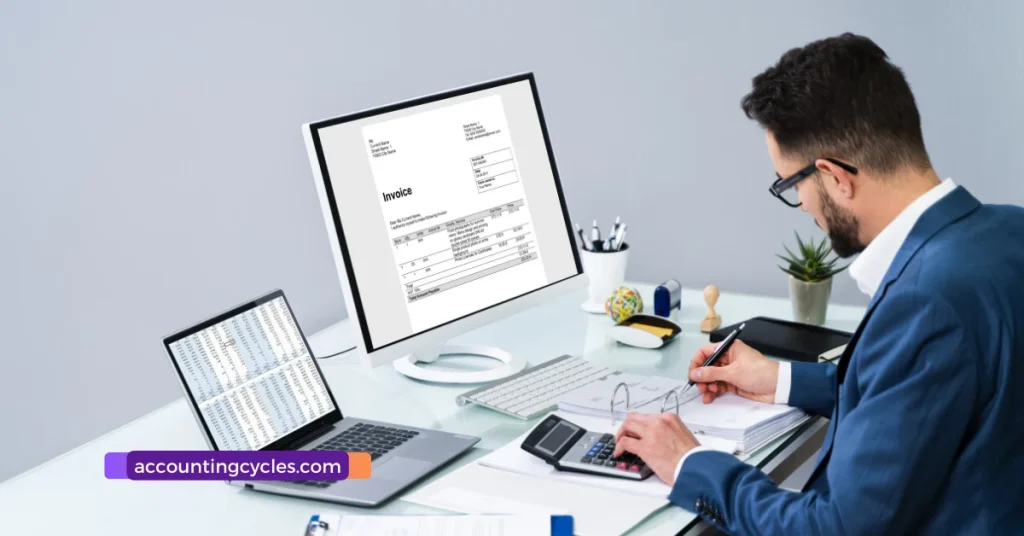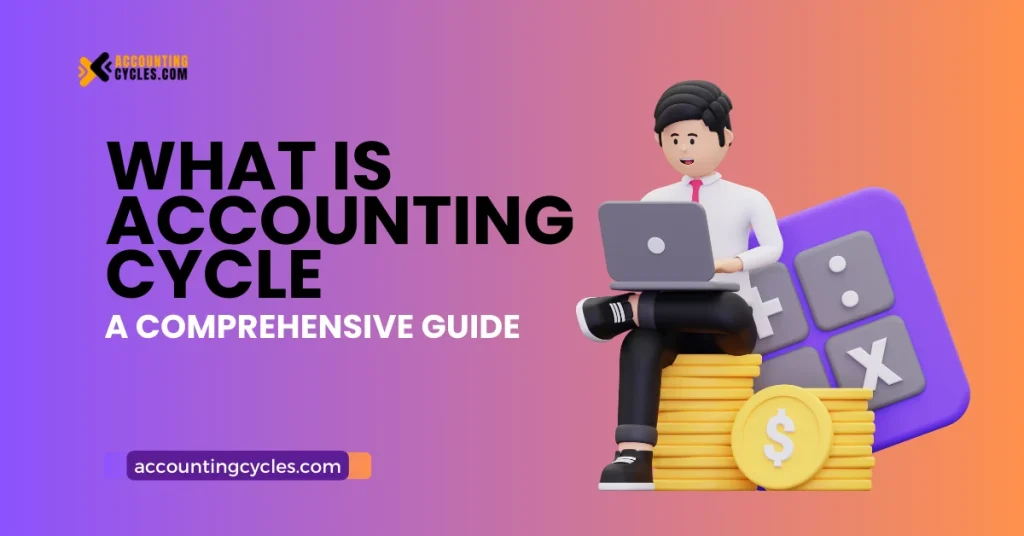In today’s writing, we will try to comprehend what is an accounting cycle. An accounting cycle refers to a procedure where all the financial statements and transactions of a business are processed and recorded. The main aim of an accounting cycle is to keep track of all the financial activities that occur during an accounting period whether monthly, quarterly, or yearly.
From the time of the transaction to the time they are added to the financial statements and eventually, the books are closed. The cycle consists of eight steps. This is called a cycle because the flow is circular moving from one step to another.
Nowadays accountants use relevant tools to process a lot of these steps in no time. An accounting cycle is a collective process and is important for every business.
Understanding the Mechanics of the Accounting Process
The mechanics of an accounting cycle have eight steps. These steps are important to understand the workings of the accounting cycle.
- Identify and Analyze Transactions
- Record Transactions in a Journal
- Post Transactions to the General Ledger
- Determine Unadjusted Trial Balance
- Analyze the Worksheet
- Adjust Journal Entries and Fix Errors
- Create Financial statements
- Closing the books
The cycle starts as the transaction is made. For instance, it can be a sale. The second step is the recording of transactions in a journal. After a journal entry is recorded the third step is to post it to general ledger.
An unadjusted trial balance is prepared in the fourth step. The fifth step is to create a worksheet of debit and credit entries. The sixth step is to adjust journal entries to fix errors and any differences in the balance sheets. The seventh step is to create financial statements for the accounting period.
The last step of the accounting cycle is the closure of books. The above-mentioned 8 steps are a complete accounting cycle.
Significance of Accounting Cycle in Business Operations
The significance of accounting cycle in business cannot be understated or neglected. An accounting cycle is a crucial aspect of any business, be it small-scale, or medium-scale. In today's era, where everything has been digitalized accounting cycle holds great significance in business operations.
An accounting cycle helps the owners to know the exact position and standing of the business. It is always preferred to know the ground reality rather than make assumptions. It provides a framework for running business activities that contain financial transactions.

It ensures compliance with federal rules and regulations. It helps the owners to monitor and keep a reality check on their firm. It helps to generate reliable financial statements which are important while making important decisions.
An accounting cycle is important because it can help ensure that the financial transactions that occur throughout an accounting period are accurately and properly recorded and reported. By doing so efficiently, one can ensure the maximum use of resources with time.
A deep understanding of an accounting cycle is needed for anyone who is managing the finances of a business.
Steps of Accounting Cycle
This accounting cycle process makes accounting easier for bookkeepers and the business community. The accounting cycle is composed of eight steps that are explained briefly below.

1 Identify and Analyze Transactions
The initial step is to identify and record all the financial transactions. This refers to all the money that is debited and credited during a specified period. These transactions may contain a purchase, rent, a loan, or any other form of expense. Identifying every activity that contains a financial transaction relating to the business is the first task.
2 Record Transactions in a Journal
Accountants use special forms to keep track of all business transactions. Journals are often referred to as book of original entry. Once the transactions have been identified, the next step is to record these entries in the journal in chronological order. This refers to debiting and crediting one or more accounts but they must always balance in the end. These entries are based on a receipt or sale.
3 Post Transactions to the General Ledger
As the transaction is recorded in a journal entry, it should now be posted to an account in the general ledger. A general ledger provides a step-wise breakdown of all the activities of the accounts. A general ledger is a means of keeping all the records of the total financial accounts.
Accounts typically recorded in a GL are assets, liabilities, expenses, etc. The ledger used to be standard for recording transactions earlier but now most of the process is done electronically through software.
4 Determine Unadjusted Trial Balance
After the journal entries are recorded to individual general ledger accounts, an unadjusted trial balance is made. An unadjusted trial balance is the account balance that is directly being reported from the general ledger.
A trial balance informs about the unadjusted balances in each account. The main aim is to highlight any errors that have taken place during the transaction recording process. It can be an error of omission of a transaction. The trial balance ensures that total debits equal total credits in the financial records.
5 Analyze the Worksheet
A worksheet is useful for ensuring that accounting entries are recorded correctly. The fifth step is to create and analyze a worksheet and ensure that debits and credits are equal. In case of any variance, adjusting entries will be required.
6 Adjust Journal Entries and Fix Errors
After making adjustments, an adjusted trial balance is prepared. Like the trial balance, this is made to verify that the credits and debits match after adjusted entries are made. Adjustments are recorded as journal entries where needed. The adjusted trial balance is the most accurate data available on all the financial activities of a firm.
7 Create Financial statements
The seventh step is to create financial statements. After posting the adjusting entries, an adjusted trial balance is created followed by the financial statements. Financial statements are accounting reports that summarize a company’s performance for a specific period. The three important financial statements that companies generate are the income statement, the balance sheet, and the cash flow statement.
8. Close the books
To close out your journal for a specific period, a company ends the accounting cycle with the closing of books. Closing of books is a time-consuming process that accounts for the transfer of temporary account balances to permanent accounts.
Thus record these balances into permanent balance sheet records and add them into official financial data. Begin the entire cycle for the next period with zero balances in these accounts for a new reporting period. Planning for the next period is the appropriate time after closing of books.
Advantages of Accounting Cycle
1 Bookkeeping of Transactions
Keeping a record of all the transactions in real time is a difficult process. The accounting cycle can help a company in keeping accurate data. This accounts for not missing out on any transaction. It helps in managing a firm, business, or organization successfully.
2 Decision Making
As real-time data is present, it helps in crucial decision-making on time. It aids the management in making decisions on different financial matters. It can be related to a new purchase of an asset or a new project to enhance the profits and sales of the company. Right decisions taken timely always make the difference, because any delay can cause a major loss to the firm.
3 Helps in Taxation and Legal Matters
It helps in Legal Compliance and Taxation related matters. For instance, management has to ensure that they are following the standard procedures and protocols while keeping the financial data intact. By following the applicable accounting techniques and standards in preparing the financial statements.
Calculating the total amount of income generated to pay income tax. Also, GST as per the laws if applicable. This is the key factor in the growth of any organization. Hence the financial data should always be real or one would face grave consequences sooner or later.
4 Accurate Financial Position
Owners, Investors, and stakeholders are always curious to know the Financial position and performance of the business or activity. Be it profit or loss everyone wants to remain aware of the standings of the business all the time. Financial statements help to depict a picture of the financial standing of a business.
5 Prevention from Frauds
The accounting system helps in the prevention of fraud, errors, and forgery. As a lot of transactions are taking place with time. Therefore, the chances of fraudulent activities are always high. It is the responsibility of the management to ensure that proper procedures are followed to avoid any fraud or forgery being committed.
Disadvantages of Accounting cycle
1 Historical Costs
Accounting is being done based on the historical costs. It uses historical value. It fails to account for the increase or decrease in value as of the present day. The data might be misleading if there is a difference between the historical costs and the current market value.
2 Accounting Background
To understand the accounting cycle, one needs to have a deep understanding of the accounting principles and practices first. Accounting itself is a tough major in college. Therefore, to implement an accounting cycle one must have sound knowledge of accounting first. So that desired results can be achieved without experiments.
3 Implementation is Expensive
The cost of initial setup or hiring trained staff is expensive. The implementation of a complete accounting cycle in a firm is costly. Hence, it is nearly impossible for small firms to adopt this method. This can be implemented in established organizations because record-keeping of all the transactions and following the complete cycle involves resources and is expensive.
4 Misleading Information
The information in the process can be forged by the management to show a positive image of the firm. The management could create secret reserves of capital for the desired purposes. This will again give incorrect or misleading information in financial statements.
5 Prone to Human Error
No matter how much investment is made to make it foolproof. The accounting cycle always has a slight chance of error. It might be intentional or unintentional. As different people engage in this process at different stages, therefore, it can always contain an error. Hence a probability of fraud or forgery always remains.
6 Based on Estimates
Sometimes estimation may be required as it is not possible to establish exact amounts. However, these estimates will vary from person to person. These estimates may be inaccurate and will provide false information for processing.
Final Thoughts
The final decision of employing an accounting cycle or not rests with the decision-makers. It holds prime importance in the digital world today because of the advantages it holds over methods that were previously being incorporated.
This cycle is significant for any firm to keep its finances organized because it tracks every penny going in or outside the firm. The accounting cycle is the need of the time. Although we have to face certain limitations while using the accounting cycle.
These disadvantages can be minimized to some extent by applying this concept efficiently. Hence the firm can retain the profits and also always have a clear view about the direction of the firm.
FAQs
1 Why do we use the accounting cycle?
The main objective of the accounting cycle is to keep a record of all financial activities that take place during a specified period. The accounting cycle verifies that every cent going into or out of the general ledger account is being reported. It is a way to monitor every financial transaction that takes place in a specific period.
2 What is accounting cycle in accounting?
The accounting cycle in accounting is referred to as an eight-step procedure that records and examines all financial activities that take place within a business during a specified period. The cycle starts over as the eight steps are completed following the same practice till the company exists. It starts when a transaction is carried out and ends when a financial statement is issued and the books are closed.
3 What is the difference between a journal and a ledger?
A journal is a book where a detailed description of all the financial transactions regarding a particular business is recorded. Whereas, a ledger is a book where these already recorded transactions are permanently recorded as credits and debits. A journal aims to facilitate the preparation of a ledger. A ledger's purpose is to record all the information needed to generate financial statements.
4 What is the difference between the accounting cycle and the budget cycle?
The accounting cycle focuses on events during a specific period and makes sure financial transactions are recorded accurately. An accounting cycle records transactions that have taken place. A budget cycle is associated with future performance and helps plan future transactions. A budget cycle takes into account transactions that might take place in the future.
5 What is the most important part of the accounting cycle?
The financial statements are the most important part of the accounting cycle. It provides confidential information about a firm’s financial performance and standing. These financial statements can be used to make major decisions regarding the firm.





